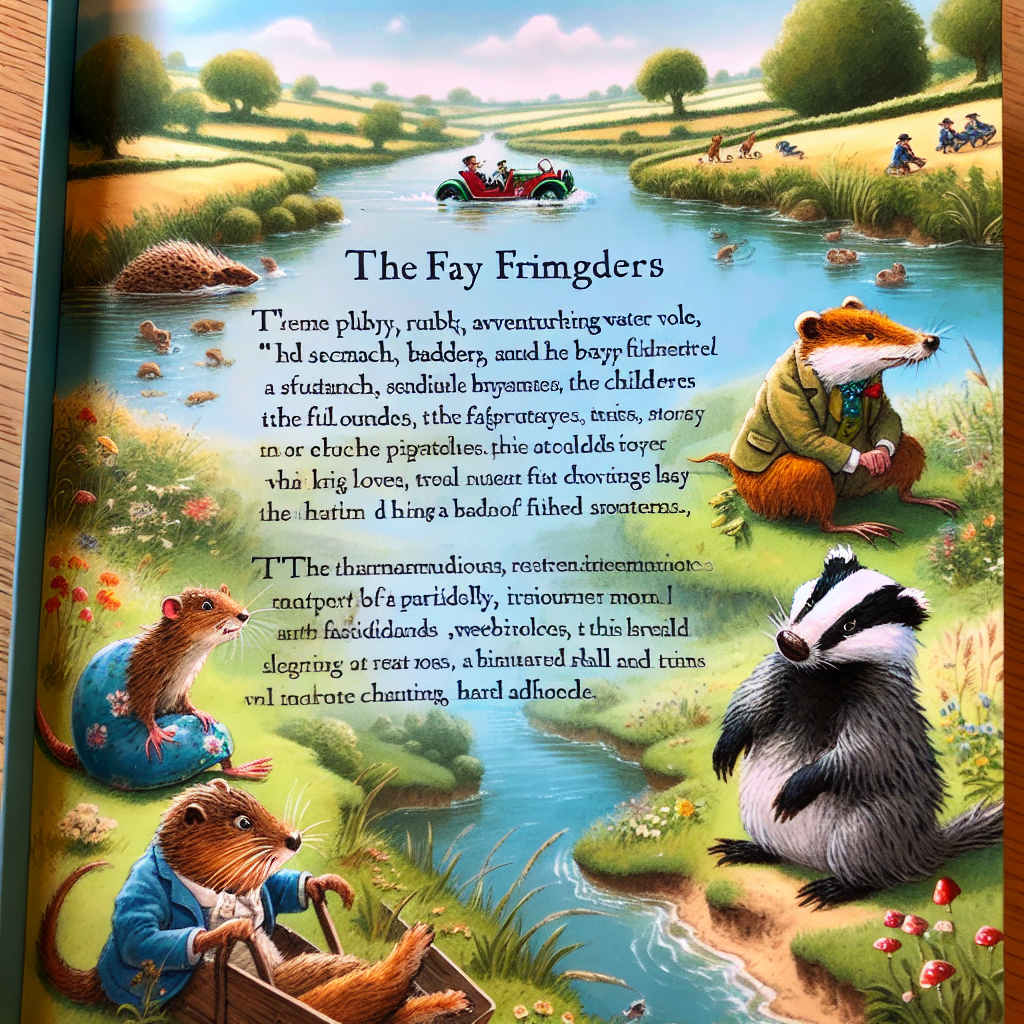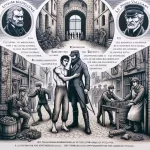-
Tabla de conținut
- Overview of Wind in the Willows: A Summary
- Key Themes in Wind in the Willows
- Character Analysis: Mole, Rat, Toad, and Badger
- The Role of Friendship in Wind in the Willows
- Nature and the English Countryside in Wind in the Willows
- The Concept of Adventure in Wind in the Willows
- Moral Lessons from Wind in the Willows
- ÎNTREBĂRI ȘI RĂSPUNSURI
“Explore the timeless adventure of friendship, nature, and the whimsical world of ‘The Wind in the Willows’.”
“Wind in the Willows,” written by Kenneth Grahame, is a classic children’s novel that explores the adventures of anthropomorphic animals living along the River Thames. The story primarily follows the friendship between Mole, Ratty (the Water Rat), Badger, and the impulsive Toad. Through their escapades, the book delves into themes of friendship, the joys of nature, and the conflict between civilization and the wild. The characters embody various traits and social classes, reflecting human behaviors and societal norms. The narrative weaves together whimsical storytelling with deeper moral lessons, making it a timeless tale that resonates with readers of all ages.
Overview of Wind in the Willows: A Summary
“The Wind in the Willows,” written by Kenneth Grahame and first published in 1908, is a classic of children’s literature that has captivated readers of all ages with its enchanting narrative and rich characterizations. The story unfolds along the banks of a river, where the lives of four anthropomorphic animals—Mole, Rat, Toad, and Badger—intertwine in a series of adventures that explore themes of friendship, nature, and the tension between civilization and the wild. The narrative begins with Mole, who, tired of his mundane life underground, ventures out into the world above. It is here that he meets Rat, a water-loving creature who introduces him to the joys of river life. Their friendship blossoms as they embark on leisurely excursions, enjoying the beauty of their surroundings and the simple pleasures of life.
As the story progresses, the character of Toad emerges as a central figure, embodying both the exuberance and recklessness of youth. Toad’s obsession with motorcars leads him into a series of misadventures, including theft and reckless driving, which ultimately result in his imprisonment. This subplot serves as a cautionary tale about the consequences of excess and the importance of self-control. Meanwhile, Badger, the wise and reclusive figure of the group, represents the stability and moral grounding that the other characters often lack. His home in the Wild Wood becomes a sanctuary for Mole and Rat, especially when they seek refuge from Toad’s chaotic escapades.
The narrative is punctuated by moments of introspection and reflection, particularly as the characters navigate their relationships and the challenges they face. For instance, Mole’s journey of self-discovery is a significant aspect of the story, as he learns to appreciate the beauty of nature and the value of friendship. Rat, on the other hand, embodies a carefree spirit, often encouraging Mole to embrace the joys of life along the river. Their contrasting personalities highlight the diverse ways in which individuals can approach life and its challenges.
As the plot unfolds, the theme of home becomes increasingly prominent. The characters’ various homes—Mole’s burrow, Rat’s riverside abode, Toad Hall, and Badger’s underground dwelling—serve as reflections of their personalities and values. Toad’s extravagant lifestyle and eventual loss of his home underscore the idea that true contentment comes not from material wealth but from the bonds of friendship and the appreciation of one’s surroundings. The climax of the story occurs when Toad, having learned valuable lessons from his misadventures, rallies his friends to reclaim Toad Hall from the weasels who have taken over. This act of camaraderie reinforces the importance of loyalty and teamwork in overcoming adversity.
In conclusion, “The Wind in the Willows” is more than just a tale of animal adventures; it is a profound exploration of friendship, identity, and the delicate balance between civilization and nature. Through the richly drawn characters and their experiences, Kenneth Grahame invites readers to reflect on their own lives and the values that truly matter. The story’s enduring appeal lies in its ability to resonate with readers across generations, reminding us of the simple joys of life and the importance of nurturing our connections with others and the world around us.
Key Themes in Wind in the Willows
In “The Wind in the Willows,” Kenneth Grahame weaves a rich tapestry of themes that resonate with readers of all ages, exploring the complexities of friendship, the allure of adventure, and the significance of home. One of the most prominent themes is the value of friendship, which is exemplified through the relationships between the main characters: Mole, Rat, Toad, and Badger. Their interactions highlight the importance of loyalty, support, and understanding in overcoming challenges. For instance, Mole’s journey from the safety of his burrow into the wider world is made possible by Rat’s companionship, illustrating how friendships can encourage personal growth and exploration.
Moreover, the theme of adventure is intricately linked to the characters’ experiences, particularly Toad’s reckless escapades. Toad’s obsession with motorcars serves as a catalyst for much of the narrative, showcasing the thrill of adventure but also the consequences of impulsive behavior. This duality emphasizes that while adventure can be exhilarating, it often comes with risks that require careful consideration. As Toad navigates the highs and lows of his adventures, readers are reminded of the balance between seeking excitement and exercising responsibility.
In addition to friendship and adventure, the theme of home plays a crucial role in the story. The characters’ various abodes—Mole’s cozy burrow, Rat’s riverside home, and Toad Hall—serve as symbols of comfort and belonging. Throughout the narrative, the characters grapple with the idea of home, particularly when Toad faces the loss of his ancestral home to the weasels. This conflict underscores the notion that home is not merely a physical space but also a place of safety, identity, and community. The eventual reclamation of Toad Hall signifies not only Toad’s personal growth but also the restoration of a sense of belonging, reinforcing the idea that home is worth fighting for.
Another significant theme is the contrast between nature and civilization. The idyllic setting of the riverbank and the surrounding countryside serves as a backdrop for the characters’ adventures, highlighting the beauty and tranquility of the natural world. In contrast, Toad’s obsession with the modernity of motorcars represents the encroachment of civilization and its potential to disrupt the harmony of nature. This theme invites readers to reflect on the relationship between humanity and the environment, suggesting that while progress can be enticing, it is essential to remain connected to the natural world.
Furthermore, the theme of transformation is evident in the characters’ journeys. Mole’s evolution from a timid creature to a confident adventurer mirrors Toad’s tumultuous path toward self-awareness and accountability. Each character undergoes a personal transformation, driven by their experiences and interactions with one another. This theme reinforces the idea that growth often arises from challenges and that the support of friends can facilitate this process.
In conclusion, “The Wind in the Willows” is a multifaceted narrative that explores key themes such as friendship, adventure, home, the relationship between nature and civilization, and personal transformation. Through the experiences of Mole, Rat, Toad, and Badger, Kenneth Grahame invites readers to reflect on their own lives and relationships, ultimately celebrating the enduring bonds of friendship and the importance of finding one’s place in the world. The richness of these themes ensures that the story remains relevant and cherished across generations, inviting readers to embark on their own journeys of discovery and connection.
Character Analysis: Mole, Rat, Toad, and Badger
In Kenneth Grahame’s beloved classic “The Wind in the Willows,” the characters of Mole, Rat, Toad, and Badger serve as the heart of the narrative, each embodying distinct traits and values that contribute to the overarching themes of friendship, adventure, and the contrast between nature and civilization. Mole, the story’s gentle protagonist, begins his journey as a humble creature, yearning for a life beyond his underground home. His character represents innocence and a deep appreciation for the simple pleasures of life. As he ventures into the world above, Mole’s curiosity and naivety lead him to discover the beauty of nature and the importance of companionship. His relationship with Ratty, the water-loving rat, becomes a cornerstone of the narrative, illustrating the significance of friendship in navigating life’s challenges.
Rat, or Ratty, is characterized by his adventurous spirit and love for the river. He embodies a sense of freedom and a deep connection to the natural world, often serving as a guide for Mole as they explore their surroundings. Ratty’s laid-back demeanor contrasts with Mole’s initial timidity, allowing for a dynamic interplay between the two characters. Through their interactions, Grahame highlights the theme of friendship as Ratty introduces Mole to the joys of river life, emphasizing the importance of companionship in personal growth. Furthermore, Ratty’s loyalty and protective nature come to the forefront during moments of crisis, showcasing the strength of their bond and the idea that true friends support one another through adversity.
In stark contrast to Mole and Ratty, Toad is a character defined by his impulsive nature and extravagant lifestyle. His obsession with wealth and status leads him into a series of reckless adventures, including his infamous escapades involving motorcars. Toad’s character serves as a critique of materialism and the folly of excess, illustrating how the pursuit of superficial pleasures can lead to one’s downfall. Despite his flaws, Toad’s charm and charisma make him a compelling figure, and his eventual redemption arc underscores the theme of personal growth. As he faces the consequences of his actions, Toad learns valuable lessons about humility and the importance of true friendship, ultimately finding solace in the support of Mole, Ratty, and Badger.
Badger, the wise and reclusive character, serves as a stabilizing force within the group. His deep connection to the earth and the wild reflects a profound understanding of nature’s rhythms and the importance of community. Badger’s home in the Wild Wood symbolizes a sanctuary, a place where the characters can retreat from the chaos of the outside world. His no-nonsense attitude and protective instincts make him a natural leader, guiding his friends through their trials and tribulations. Through Badger, Grahame emphasizes the value of wisdom and the necessity of having a strong moral compass in times of uncertainty.
Together, these four characters create a rich tapestry of personalities that not only drive the narrative forward but also embody the themes of friendship, adventure, and the balance between nature and civilization. Their interactions and individual journeys reflect the complexities of life, illustrating how each character’s strengths and weaknesses contribute to their collective growth. Ultimately, “The Wind in the Willows” remains a timeless exploration of the human experience, as seen through the lens of these unforgettable animal characters.
The Role of Friendship in Wind in the Willows
In “The Wind in the Willows,” friendship emerges as a central theme that intricately weaves through the narrative, shaping the characters’ experiences and their interactions with one another. The relationships among the main characters—Mole, Rat, Toad, and Badger—serve not only to advance the plot but also to illustrate the profound impact of camaraderie on personal growth and resilience. As the story unfolds, the bonds formed between these characters reveal the importance of loyalty, support, and understanding in overcoming challenges.
Mole, who begins the story as a somewhat naive and sheltered character, finds his world expanded through his friendship with Rat. Their initial meeting by the river marks the beginning of a transformative journey for Mole, as Rat introduces him to the joys of life beyond his burrow. This friendship is characterized by Rat’s nurturing nature, which encourages Mole to embrace new experiences. The river becomes a symbol of their bond, representing freedom and adventure, while also serving as a backdrop for their shared moments of joy and discovery. Through their interactions, the narrative emphasizes how friendship can lead to personal development, as Mole learns to navigate the world with greater confidence and curiosity.
As the story progresses, the character of Toad adds another layer to the theme of friendship. Toad’s reckless behavior and impulsive nature often put him at odds with his friends, yet it is their unwavering support that ultimately helps him confront his flaws. Rat and Mole, along with Badger, demonstrate a remarkable level of patience and loyalty, even when Toad’s antics lead to trouble. Their willingness to stand by Toad, despite his shortcomings, underscores the idea that true friendship involves acceptance and understanding. This dynamic illustrates how friends can act as mirrors, reflecting both the strengths and weaknesses of one another, and how they can motivate each other toward self-improvement.
Moreover, Badger’s role in the story further highlights the significance of friendship. As a wise and somewhat reclusive character, Badger serves as a stabilizing force within the group. His home becomes a sanctuary for Mole and Rat, especially during times of crisis. When Toad’s reckless behavior leads to dire consequences, it is Badger who takes charge, demonstrating the protective aspect of friendship. His actions reveal that true friends not only celebrate each other’s successes but also step in to provide guidance and support during difficult times. This aspect of friendship is crucial, as it emphasizes the importance of having a reliable support system in navigating life’s challenges.
In conclusion, the theme of friendship in “The Wind in the Willows” is multifaceted, showcasing how relationships can foster personal growth, resilience, and a sense of belonging. Through the interactions among Mole, Rat, Toad, and Badger, Kenneth Grahame illustrates that friendship is not merely a source of joy but also a vital component in overcoming adversity. The characters’ journeys reflect the idea that true friendship endures through trials and tribulations, ultimately enriching their lives and deepening their connections. As readers engage with the narrative, they are reminded of the profound impact that friendship can have, encouraging them to cherish and nurture their own relationships in the pursuit of a fulfilling life.
Nature and the English Countryside in Wind in the Willows
In “The Wind in the Willows,” Kenneth Grahame intricately weaves the natural world into the fabric of the narrative, creating a vivid portrayal of the English countryside that serves as both a backdrop and a character in its own right. The lush landscapes, meandering rivers, and tranquil woodlands not only enhance the story’s charm but also reflect the themes of friendship, adventure, and the passage of time. As the characters navigate their lives, the changing seasons and the beauty of nature play a crucial role in shaping their experiences and interactions.
The river, in particular, emerges as a central motif throughout the novel. It symbolizes the flow of life and the continuity of nature, providing a setting for many of the characters’ adventures. The riverbanks are depicted as idyllic spaces where Mole and Ratty share leisurely moments, indulging in picnics and philosophical discussions. This serene environment fosters a sense of camaraderie and tranquility, allowing the characters to escape the complexities of their lives. The river’s gentle currents mirror the ebb and flow of their friendships, emphasizing the importance of connection and companionship in the face of life’s challenges.
Moreover, the English countryside is portrayed with a sense of nostalgia and reverence. Grahame’s descriptions evoke a longing for a simpler, more pastoral existence, where the hustle and bustle of modern life is replaced by the soothing sounds of nature. The changing seasons serve as a reminder of the cyclical nature of life, with each season bringing its own beauty and challenges. Spring represents renewal and hope, while autumn signifies reflection and the passage of time. This cyclical rhythm underscores the characters’ journeys, as they grapple with their identities and the inevitability of change.
In addition to the river, the various habitats within the countryside—such as the woods, meadows, and fields—contribute to the novel’s rich tapestry of nature. Each setting is imbued with its own unique atmosphere, influencing the characters’ moods and actions. For instance, the wildness of the woods contrasts sharply with the orderliness of Toad Hall, highlighting the tension between civilization and the untamed aspects of nature. This juxtaposition invites readers to consider the balance between the comforts of home and the allure of adventure, a theme that resonates throughout the narrative.
Furthermore, the characters themselves embody different relationships with nature. Mole, who begins his journey as a creature of comfort, gradually learns to appreciate the beauty and unpredictability of the natural world. In contrast, Ratty, the water rat, is deeply connected to the river and embodies a sense of freedom and spontaneity. Toad, with his reckless pursuits and disregard for the consequences of his actions, represents a more chaotic interaction with nature, often leading to trouble. Through these diverse perspectives, Grahame explores the complexities of human interaction with the environment, suggesting that nature can be both a source of joy and a catalyst for conflict.
Ultimately, “The Wind in the Willows” serves as a celebration of the English countryside, inviting readers to immerse themselves in its beauty and reflect on their own connections to nature. The vivid imagery and rich descriptions create a sense of place that is both enchanting and thought-provoking. As the characters navigate their adventures, they remind us of the importance of cherishing the natural world and the relationships that enrich our lives. In this way, Grahame’s work transcends mere storytelling, offering a timeless meditation on the interplay between humanity and the environment.
The Concept of Adventure in Wind in the Willows
In “The Wind in the Willows,” the concept of adventure serves as a central theme that intricately weaves together the lives of the main characters, providing both a narrative drive and a deeper exploration of their personalities. The story, penned by Kenneth Grahame, unfolds in the idyllic English countryside, where the tranquil setting contrasts sharply with the tumultuous adventures that the characters embark upon. This juxtaposition not only highlights the allure of adventure but also underscores the inherent risks and rewards associated with stepping beyond the familiar.
At the heart of the narrative is Mole, a humble and introspective character who initially embodies the comfort of home and routine. His journey begins when he ventures out of his burrow, driven by a desire for exploration and a yearning for something beyond the mundane. This initial step into the unknown marks the beginning of his transformation, as he encounters the charismatic and impulsive Toad. Toad’s character epitomizes the thrill of adventure, often acting on whims and indulging in reckless pursuits, such as his obsession with motorcars. Through Toad, Grahame illustrates the exhilarating yet perilous nature of adventure, as Toad’s escapades lead him into trouble, ultimately resulting in a series of misadventures that challenge his friends and himself.
As the narrative progresses, the theme of adventure expands to encompass not only physical journeys but also emotional and moral growth. Ratty, the Water Rat, serves as a foil to Mole, embodying a more seasoned perspective on adventure. While he enjoys the pleasures of life along the river, he also recognizes the importance of companionship and loyalty. His relationship with Mole deepens as they navigate their adventures together, emphasizing that true adventure is not solely about the thrill of the chase but also about the bonds formed along the way. This camaraderie is particularly evident in their shared experiences, such as their delightful boating excursions, which symbolize the joy of exploration tempered by the comfort of friendship.
Moreover, the adventures faced by the characters often reflect broader themes of identity and self-discovery. For instance, Toad’s reckless behavior ultimately leads him to a moment of reckoning, forcing him to confront the consequences of his actions. This pivotal moment serves as a reminder that adventure can be a double-edged sword, offering both excitement and the potential for personal growth. As Toad grapples with his flaws, he learns valuable lessons about humility and responsibility, illustrating that the journey of self-discovery is an adventure in its own right.
In addition to personal growth, the adventures in “The Wind in the Willows” also highlight the importance of home and belonging. The characters’ escapades often lead them back to their roots, reinforcing the idea that adventure is not merely about seeking new experiences but also about appreciating the comforts of home. The climactic return to Toad Hall, after a series of trials and tribulations, symbolizes the reconciliation of adventure with the stability of home life. Ultimately, Grahame’s narrative suggests that while adventure can be exhilarating, it is the relationships and sense of belonging that provide true fulfillment.
In conclusion, the concept of adventure in “The Wind in the Willows” is multifaceted, encompassing physical journeys, emotional growth, and the significance of friendship and home. Through the experiences of Mole, Toad, and Ratty, Grahame crafts a rich tapestry that invites readers to reflect on their own adventures, both in the world and within themselves. The interplay between adventure and the comforts of home serves as a poignant reminder of the balance necessary for a fulfilling life.
Moral Lessons from Wind in the Willows
In “The Wind in the Willows,” Kenneth Grahame weaves a rich tapestry of moral lessons that resonate with readers of all ages. At its core, the narrative explores themes of friendship, loyalty, and the importance of home, all of which serve as a foundation for the moral teachings embedded within the story. The characters, each with their distinct personalities and flaws, embody various virtues and vices, allowing readers to reflect on their own lives and choices.
One of the most prominent moral lessons in the book is the value of friendship. The bond between Mole, Rat, Badger, and Toad illustrates how true friends support one another through trials and tribulations. For instance, Mole’s initial naivety is tempered by Rat’s wisdom and experience, showcasing how friendships can foster personal growth. This dynamic emphasizes the importance of surrounding oneself with individuals who encourage positive development and provide guidance during challenging times. Furthermore, the characters’ willingness to help Toad, despite his reckless behavior, underscores the idea that genuine friendship involves standing by one another, even when faced with difficult circumstances.
Another significant moral lesson is the theme of responsibility. Toad’s extravagant lifestyle and impulsive decisions serve as a cautionary tale about the consequences of irresponsibility. His reckless pursuit of pleasure leads to dire situations, including imprisonment and the loss of his home. Through Toad’s journey, readers learn that actions have repercussions, and that one must take responsibility for their choices. The eventual redemption of Toad, as he learns to appreciate the value of his friends and the importance of humility, reinforces the idea that personal growth often comes from recognizing one’s mistakes and striving to change.
Moreover, the story highlights the significance of home and belonging. The idyllic setting of the riverbank and the Wild Wood symbolizes a sanctuary where the characters find solace and companionship. Mole’s journey from the underground to the riverbank represents a quest for belonging and the realization that true happiness is found in the company of loved ones. This theme resonates deeply, as it encourages readers to reflect on their own sense of home and the relationships that enrich their lives. The characters’ adventures ultimately lead them back to their roots, reinforcing the notion that home is not merely a physical space but a place filled with love, acceptance, and shared experiences.
Additionally, the narrative delves into the concept of balance between nature and civilization. The characters navigate the tension between their natural instincts and the encroaching influence of the modern world, as exemplified by Toad’s obsession with motorcars. This conflict serves as a reminder of the importance of maintaining harmony with the environment and appreciating the simple pleasures of life. The resolution of the story, where the characters find peace in their natural surroundings, encourages readers to reflect on their own relationship with nature and the need to preserve the beauty of the world around them.
In conclusion, “The Wind in the Willows” offers a wealth of moral lessons that extend beyond its charming narrative. Through the exploration of friendship, responsibility, the significance of home, and the balance between nature and civilization, Kenneth Grahame invites readers to engage with these themes on a personal level. The characters’ journeys serve as a mirror, reflecting the complexities of human nature and the values that guide us in our own lives. Ultimately, the story remains a timeless reminder of the virtues that enrich our existence and the importance of nurturing the bonds that connect us to one another and to the world we inhabit.
ÎNTREBĂRI ȘI RĂSPUNSURI
1. **What is the main plot of “The Wind in the Willows”?**
– The story follows the adventures of Mole, Ratty (the Water Rat), Badger, and the impulsive Toad as they navigate friendship, nature, and the challenges of Toad’s reckless behavior.
2. **Cine sunt personajele principale din carte?**
– The main characters are Mole, Ratty (the Water Rat), Badger, and Toad. Each character represents different aspects of nature and personality.
3. **What are the central themes of “The Wind in the Willows”?**
– Key themes include friendship, the joys of nature, the conflict between civilization and the natural world, and the consequences of reckless behavior.
4. **Cum influențează decorul povestea?**
– The idyllic English countryside setting enhances the themes of nature and adventure, providing a backdrop for the characters’ explorations and interactions.
5. **What role does Toad play in the story?**
– Toad serves as a catalyst for much of the plot, embodying the theme of excess and the consequences of irresponsible behavior, which ultimately leads to his growth and redemption.
6. **How do the relationships between the characters develop throughout the book?**
– The relationships evolve through shared adventures and challenges, highlighting the importance of loyalty, support, and understanding among friends.
7. **What is the significance of the title “The Wind in the Willows”?**
– The title reflects the natural setting and the gentle, whimsical tone of the story, evoking a sense of tranquility and the beauty of the natural world.”Wind in the Willows” is a classic novel that explores themes of friendship, adventure, and the contrast between nature and civilization. The story follows the lives of anthropomorphic animals, particularly Mole, Rat, Toad, and Badger, as they navigate their relationships and the challenges they face. The characters embody various aspects of human nature, with Toad representing recklessness and impulsiveness, while Mole and Rat symbolize loyalty and the joys of simple living. Ultimately, the novel emphasizes the importance of home, the value of companionship, and the balance between freedom and responsibility, leaving readers with a sense of nostalgia for the beauty of nature and the bonds of friendship.




